Matador Network's Blog, page 473
May 24, 2022
How To Take a Lionfish Hunting Trip in Florida To Catch Your Own Delicious, yet Venomous, Fish

The words “hunting” and “conservation” are rarely used in concert. But in the case of venomous, voracious, and virulent lionfish, marine conservationists say the hunt is on.
Native to the South Pacific and Indian Oceans, lionfish are an invasive species in the Western Atlantic Ocean, Gulf of Mexico, and Caribbean Sea whose overwhelming proliferation is considered one of the greatest ecological threats the Atlantic has ever seen. How they got there is not entirely clear. One theory pins the escape of six captive lionfish into Florida’s Biscayne Bay on Hurricane Andrew in 1992. A more popular theory blames aquarium owners for releasing lionfish into Floridian waters where they were first spotted as far back as 1985.
In the United States, the term lionfish generally refers to two separate yet virtually indistinguishable species with brick-red bodies, white stripes, and venomous spines where their dorsal, pelvic, and anal fins are. These reef dwellers have big appetites and no natural predators in the Atlantic, spelling disaster for the native species that compete for prey and the commercial fishing industries that revolve around them. Lionfish also reproduce at an alarming rate: A mature female lionfish spawns up to 50,000 eggs every two to four days year round.
Though lionfish have been discovered everywhere from Texas to North Carolina, America’s lionfish problem is particularly pervasive in Florida. One solution the state promotes is to catch and eat them. Beneath all those fanlike spines, lionfish have mild, flaky, buttery flesh that’s been compared to Mahi Mahi, grouper, snapper, and halibut.
Lionfish hunting is not as easy as sport fishing. Because lionfish tend to dwell on reefs, shipwrecks, and other underwater structures at least 60 feet deep, most lionfish hunters use scuba gear and spearfishing equipment to harvest them. On the other hand, because Atlantic lionfish do not live in fear of natural predators, they’re generally easy to approach. Unlike many types of fishing, lionfish hunting is also highly encouraged and lightly regulated. Dive shops throughout Florida host lionfish hunting expeditions, and multiple lionfish festivals and harvesting competitions take place along the Florida coast every year.
The fact that lionfish are so invasive in Florida also means that opportunities to harvest them abound. “If you’re planning a beach vacation, there’s probably an opportunity for you,” says Sarah Peirce, the coordinator for the Florida Fish and Wildlife Conservation’s Lionfish Outreach and Control Program, who encourages anyone who’s interested to try it.
So, if you’re looking for a fun, ecologically beneficial activity to try on your next trip to the Florida coast, here’s everything you need to know about hunting, cleaning, and cooking lionfish.
A beginner’s guide to lionfish hunting in Florida
Photo: Drew McArthur/Shutterstock
There are surprisingly few rules surrounding lionfish hunting in Florida. You’re allowed to harvest as many lionfish of whatever size as you’re able to catch in both state and federal waters, and you don’t even need a license if you’re using gear that’s specifically designed and advertised for lionfish hunting, such as dip nets, Hawaiian slings, and pole spears. However, spearing is prohibited in parts of Monroe County and other protected areas, such as Everglades National Park, Dry Tortugas National Park, and state parks such as John Pennekamp and Long Key.
Pole spears and Hawaiian slings — which function a little bit like rubber band guns and slingshots, respectively — are two of the most common lionfish hunting tools. It’s possible to lug these tools around while freediving, but in most cases, you’re going to want the aid of scuba gear while lionfish hunting.
“Scuba gear gives divers more bottom time and the ability to access deeper reef sites,” Peirce explains, noting that lionfish have been spotted in waters ranging from one foot to 1,000 feet deep but are commonly found in waters from 60 to 100-plus feet deep. There are no specific regulations surrounding the level of certification divers need to hunt lionfish in Florida, but it’s important to respect the limits of your training and experience, whether you’re an open water diver, advanced open water diver, or have technical or professional certifications.
Because lionfish are venomous, divers should take extra precautions on harvesting trips. Puncture-resistant gloves are key when handling lionfish, and it’s helpful to bring a puncture-resistant containment unit such as a Zookeeper to store the lionfish you catch while diving.
Peirce also recommends keeping heat packs or a thermos of hot water on your dive boat to be applied immediately in the event you get stung. Lionfish stings can be incredibly painful, on rare occasions even known to induce anaphylaxis shock, and “heat is able to denature the neurotoxin contained in lionfish venom.” If you’re not able to remove a lionfish spine from a wound after being stung or experience severe muscle aches or cramps, persistent pain at the sting site, signs of infection including fever or worsening redness or swelling, faintness, or paralysis, abort your dive and visit an urgent care center.
The best places to go lionfish hunting in Florida
Photo: Vitaliy6447/Shutterstock
While lionfish can be found throughout Florida’s waters, large-scale harvesting events such as the Emerald Coast Open and Lionfish Removal and Awareness Festival often center on the Florida Panhandle — specifically the city of Destin for those events. One explanation for the high density of lionfish in the Panhandle, which anecdotal reports have revealed to be a hotspot for the species although Peirce notes that no “widescale stock assessment” has been conducted in the state, is the prevalence of “suitable habitat” in the northern Gulf of Mexico.
How deep waters plunge, what the seafloor looks like, and how frequently lionfish are harvested all impact the lionfish population — and harvesting opportunities — in a given area. In the Florida Keys, for example, lionfish tend to be more spread out than they are in the Panhandle. Home to the only living coral barrier reef in the contiguous United States, the Keys cover 125 miles of largely shallow reef where lionfish dwell, which contributes to the fact that they’re harvested year-round. Elsewhere in Florida, where the waters run deeper and artificial reefs are more prevalent, harvest pressure may be less consistent throughout the year.
If you’re traveling to the Florida Keys, open water divers might consider taking the PADI Lionfish Removal Specialist Course at Dive Key West or Lionfish Eradication Course at Islamorada Dive Center. In the Panhandle, operators such as Niuhi Dive Charters, Florida Dive Pros, and Jolly Rogers Dive Charters lead lionfish hunting expeditions out of Pensacola, which is sometimes branded as the “Lionfish Capital of the World.” In southeastern Florida, the town of Jupiter in Palm Beach County has also become a popular spot for lionfish hunting.
For even more opportunities, the Florida Fish and Wildlife Conservation Commission charts the location of every public artificial reef in the state, where lionfish are often found dwelling on high relief structures such as concrete pyramids and modules. More than 3,800 artificial reefs have been set up off Florida’s coast since the 1940s, and their coordinates can be found here.
How to clean and cook your lionfish catches
Photo: BearFotos/Shutterstock
Once you’ve harvested a Zookeeper full of lionfish, the most environmentally responsible way to dispose of your catches is also the most delicious: eat them.
Filleting lionfish is just like filleting any other fish — once you’ve removed the venomous spines. While this is not strictly necessary, lionfish can sting you even after they’re dead, so you’re going to want to de-spine them while you have your puncture-resistant gloves handy.
To do so, first remove the 13 dorsal spines running along the top of the lionfish while holding it by the head, working back to front using kitchen shears. Then remove the first spine of each pelvic fin and the first three spines of the anal fin. You should count 18 venomous spines in total. You may also want to remove the non-venomous ventral fins on the fish’s belly. From there, the process will start to look more familiar: scaling, gutting, rinsing, and finally filleting.
Another option is to leave the cleaning to the pros. In coastal Florida, it’s not uncommon to see lionfish on restaurant menus. Several restaurants will also cook your catches for you. At Castaway in Marathon in the Florida Keys, a proud partner of the non-profit organization Lionfish Central, both options are available to divers and diners alike.
Even celebrity chefs such as José Andrés have started serving lionfish at their restaurants to do their part to eradicate the invasive species. At his fine-dining restaurant Fish at The Cove at Atlantis on Paradise Island in the Bahamas, lionfish is fried whole; on an episode of Gordon Ramsay’s reality cooking show The F Word, the chef is seen hunting lionfish in Islamorada before whipping up a Caribbean fish curry back at harbor. Other popular lionfish preparations include ceviche, fritters, and tacos. 
These Santa Cruz Airbnb Rentals Are the Perfect Escape for Surfers, Artists, and Beach Lovers

Sunny and colorful, Santa Cruz is your quintessential California beach town where life revolves around exquisite beaches and parks. When you’re not strolling the Boardwalk, cycling West Cliff Drive, or catching a wave, you need somewhere to get your beauty sleep. Here’s the best of the Airbnb Santa Cruz vacation homes for couples, families, and surfers.
Unique Airbnbs in Santa CruzSanta Cruz Airbnbs with poolSanta Cruz beach house Airbnb rentalsWe hope you love the Santa Cruz Airbnb rentals we recommend! Just so you know, Matador may collect a small commission from the links on this page if you decide to book a stay. Listed prices are accurate as of the time of publication.
Unique Airbnbs in Santa CruzLuxurious historic windmill silo house
Photo: Airbnb

Photo: Airbnb

Photo: Airbnb

Photo: Airbnb
Whimsical and magical yet perfectly functional, this kooky windmill Airbnb Santa Cruz sits on the bank of Soquel Creek in Capitola Village. Rental grants access to three dwellings on the same plot – a windmill, a silo, and a renovated vintage trailer. Interior spaces across both units are brought to life with every color under the sun while all bedrooms offer water views. Bonus facilities include a ping pong table, hot tub, and putting green.
Twelve guests, six bedrooms
Price: $1,300 per night

Photo: Airbnb

Photo: Airbnb

Photo: Airbnb

Photo: Airbnb
This Mediterranean-style villa is kitted out with top-tier appliances and materials including a chef’s kitchen, French limestone, reclaimed pine floors, and a home movie theater. Gaze across Monterey Bay from the infinity pool and hot tub before heading indoors for a game of billiards and a cocktail from the bar. If this isn’t luxurious enough, the host has a private chef and professional massage therapist on speed dial.
Ten guests, five bedrooms
Price: $1,995 per night

Photo: Airbnb

Photo: Airbnb

Photo: Airbnb

Photo: Airbnb
Located in the tranquil Capitola Village, this beautiful Santa Cruz Airbnb vacation rental offers ocean views. External decks and the backyard are surrounded by trees for privacy but that doesn’t stop this place from being a real suntrap. Facilities include a swimming pool, grill, ping pong table, and outdoor dining area. Besides the master and a kid-friendly twin room, the pool house accommodates a further two guests.
Six guests, three bedrooms
Price: $430 per night

Photo: Airbnb

Photo: Airbnb

Photo: Airbnb

Photo: Airbnb
Checking into this luxury home feels akin to stepping into a glossy magazine. Rooms are artistically appointed with designer furniture including a Le Corbusier chair and Chesterfield sofa. The blue-tiled bathroom with a deluxe soaking tub is exactly what you need after a day of surfing, hiking, or cycling. The patio of this downtown Santa Cruz Airbnb overlooks the Boardwalk and is a 10-minute walk from the beach.
Eight guests, four bedrooms
Price: $1,125 per night
Traveling to California? Check out Matador’s California accommodations guides:These beautiful San Diego Airbnbs put you close to the beach and downtownThe best 14 Airbnbs near Yosemite National Park11 magical Airbnbs near Redwoods and Sequoia National Parks9 dreamy oceanfront Airbnbs up and down the California coast10 soulful beach Airbnbs for the perfect SoCal yoga retreat12 very zen Joshua Tree Airbnbs perfect for families and groupsBoardwalk oasis with hot tub, bikes, and surfboards

Photo: Airbnb

Photo: Airbnb

Photo: Airbnb

Photo: Airbnb
This groovy cottage is stylishly appointed with a compact yet complete kitchen and two cozy double bedrooms. The vacation home has the perk of a private backyard with a hot tub and hammock for lazy days. Exploring the area is made easy: the host provides a pair of surfboards as well as four beach cruiser bikes. Best of all, dogs are welcome at this pet-friendly Airbnb Santa Cruz.
Six guests, two bedrooms
Price: $575 per night

Photo: Airbnb

Photo: Airbnb

Photo: Airbnb
Reimagined as a modern California vacation home, this two-story Victorian pad comes with an ambient backyard with a hot tub and fire pit. Each of the two bedrooms enjoys high ceilings while the master is affixed with a picturesque balcony. This downtown Santa Cruz Airbnb near the Boardwalk is perfect for families and first-time visitors. A stash of board games as well as an arcade game adds a few extra brownie points.
Six guests, three bedrooms
Price: $465 per night

Photo: Airbnb

Photo: Airbnb

Photo: Airbnb

Photo: Airbnb
Situated in a quiet neighborhood a stone’s throw from downtown Santa Cruz and the beach, this immaculate vacation rental is a solid choice for families. The kitchen features every utensil and appliance you could possibly need – just remember to swing by one of the city’s legendary farmers’ markets. A fenced backyard offers privacy for enjoying a session in the hot tub or a barbecue dinner around the grill.
Six guests, three bedrooms
Price: $1,180 per night

Photo: Airbnb

Photo: Airbnb

Photo: Airbnb

Photo: Airbnb
Originally constructed in 1905, this historic home has been meticulously refurbished for modern needs with a country estate vibe. A spacious open-plan lounge and dining area that trickles into the kitchen is the epicenter of the home. The master bathroom features a clawfoot bathtub while the back patio comes with a Jacuzzi. There’s no extra fee to bring your dog to this pet-friendly Airbnb Santa Cruz.
Eight guests, four bedrooms
Price: $755 per night

Photo: Airbnb

Photo: Airbnb

Photo: Airbnb

Photo: Airbnb
This cute turquoise bungalow is decorated with a wholesome flair with fantastically-proportioned living quarters and bedrooms. It’s all about the backyard, where you’ll find a hot tub, bocce ball court, and hammock. Step into the games room where you’ve got a pool table and bouldering wall to keep the boredom at bay. Bikes, surfboards, and a two-person sea kayak are all thrown in for good measure.
Six guests, two bedrooms
Price: $625 per night
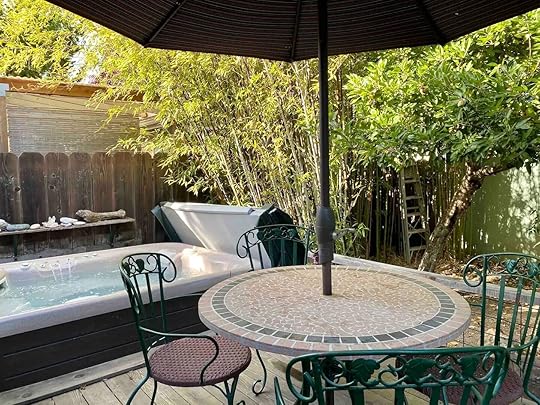
Photo: Airbnb

Photo: Airbnb

Photo: Airbnb
This pretty bungalow is packed with character. Carefully chosen art and furnishings add personality while a piano is on standby for musical guests. French doors connect the bedroom to a botanical backyard brimming with flowers. Take the tandem cruiser out for a spin and spend indulgent evenings flitting between the sauna and hot tub.
Four guests, two bedrooms
Price: $340 per night

Photo: Airbnb

Photo: Airbnb

Photo: Airbnb

Photo: Airbnb
Thoughtfully appointed and tastefully decorated, the host of this Santa Cruz Airbnb has left no stone unturned. Boutique bathing products, kitten-soft towels and bedding, and even a welcome gift ensure the highest level of comfort. A fireplace adds warmth for the evenings while the leafy patio is the perfect spot for your morning brew. Bicycles are provided as part of the rental. 
Two guests, one bedroom
Price: $375 per night
May 23, 2022
Someone Shot a Water Tower Painting of Johnny Cash To Make It Look Like He’s Peeing

While the memory of Johnny Cash has made a big splash in the minds of people who currently live in his birthplace of Kingsland, Arkansas, it’s doubtful they thought the country singer would be making it rain.
Locals added his silhouette to the water tower in tribute to the Man In Black. However, one person’s creative liberty has been decidedly unwelcome. A man was recently arrested for shooting a hole into the profile on the water tower right in the crotch area, causing a steady stream of water to look like Cash is peeing.
Although the 50,000-gallon water tower stunt was likely intended for a laugh, it’s actually causing the small town real trouble. The artwork has been “peeing” for over a week, causing 347 of the town’s residents to suffer from low water pressure and discolored water. The city is losing $200 a day, and the repair will cost another $5,000. According to TMZ, a man named Timothy Sled has been arrested and charged with impairing the operation of a vital public utility and criminal mischief — both of which are felonies.
Whoever shot the Kingsland, AR water tower is a good shot.
Looks like the silhouette of Johnny Cash has got to go! pic.twitter.com/suGV4v7vti
— Guy Still (@mplstvguy) May 15, 2022
In the meantime, mayor Luke Neal assured reporters that the town is doing everything they can to have Cash’s leak come to an end. 
I’m a Female Mountain Biker. Here’s the Protective Gear and Clothing I Actually Use.

You know how sometimes you read online gear reviews or round-ups and it kind of seems like the author based most of it on Amazon reviews?
Well, that’s not the case here. I’m an actual female mountain biker, and I actually use the gear below. I try to ride at least three time a week in the season so it’s pretty easy for me to test out mountain bike protective gear and clothing for women. I ride in all types of conditions; in fact, I just finished slogging through a mostly snow-covered trail. Hey, someone has to go see if they’re ready yet. Somedays, I opt for my usual four-mile, 600-foot climb hot lap, and other times I go all-in on 15-plus-mile rides with climbing measured by the thousands. Though I never say no to shuttle laps.
Most mountain biking accessories have no gender, like bike racks, hand pumps, and chain repair kits. If that’s what your after, scroll to the bottom of this beginner mountain bike buying guide for some good recommendations.
But when it comes to mountain bike clothing and mountain bike protective gear, there are some items that most women will prefer in women’s-specific option. Of course, if you like a “men’s” version better, you do you. As with many outdoor sports, some items are needlessly gendered. So if you like a pair of gloves or a helmet marketed to guys, go for it. But with items like padded shorts, shirts, shoes, and packs, you may see a noticeable difference when you rock a women’s version.
Some of the gear toward the bottom, like helmets and pedals, aren’t women’s-specific. They’re just awesome pieces of gear I recommend to my female mountain biking friends, whether they’re doing totally flat trails through a state park or getting seriously sendy in the woods. It’ll work for mountain biking (or mountain e-biking) and some can double for road biking, though road bikers usually have slightly different shorts and helmets, among other items.
We hope you love the mountain bike protective gear we recommend! Just so you know, Matador may collect a small commission from the links on this page if you decide to make a purchase. Listed prices are accurate as of the time of publication.
The best mountain bike protective gear and clothing for womenThe best women’s mountain bike clothingThe best women’s mountain bike protective gearThe best women’s mountain bike hard goods and accessoriesThe best women’s mountain bike clothingOuter layer: Backcountry Hero Dirt Hoodie ($55)
Were it not for the hidden features, you’d never know it was a bike shirt. Photo: Suzie Dundas
Pros: Thumb holes, back zipper, pit zips, moisture-wickingCons: Tall collar may not work for all ridersUnless it’s 80 degrees out and it’s a no-brainer that you’re wearing a tank top or T-shirt, it can be hard to know what to wear as a top layer. While you’ll likely get hot if you’re pedaling up, the combination of higher speeds, wind, and sweat on your skin can make you pretty chilly on the downhill. So for spring and fall days when it’s not quite warm enough for just a thin T-shirt, try the Dirt Hero Hoodie from Backcountry. Because it’s a pull-over, rather than a jacket, it doesn’t billow out like a sail when you hit 20 miles per hour on a downhill.
I have and love this hoodie, mostly because it’s an insanely good price for a piece of women’s mountain bike clothing loaded with features. It’s made with moisture-wicking fabric — a must for mountain biking, in my opinion — and is abrasion resistant, so you don’t need to worry about ripping the arms when you take a spill. It also has pit zips for ventilation (like a ski jacket) and a big back zippered pocket like the ones you’d find on bike racing jerseys big enough for a phone. It’s true to size but has a slim fit; I’m 5-foot, 7-inches tall and usually wear a size 6 or 8 and the medium is fitted without being roomy. Size up if you like your layers baggy, but remember that you want it to be somewhat fitted if you’re wearing it while biking. Also note that it has a high neckline, so skip it if you don’t like having fabric around your neck.
Chamois: Patagonia Nether Liner Bike Shorts ($59)
My Patagonia liners, inside-out. The purple area is padding to cushion your butt a bit from the seat while riding. Photo: Suzie Dundas
Pros: Slim profile, quick-drying, sustainable materialsCons: Padding isn’t removableThe first time I pulled on the Nether Liner Women’s Mountain Bike Short from Patagonia, I thought to myself “this ride is going to hurt.” A mountain bike chamois (but usually called a”shammy”) is a snug padded short you wear under your baggies outer shorts. It’s extra padding to protect your butt and pelvic area on bumpy trails. Most of mine are quite thick, but the Nether Liner seems to have a slimmer padded area.
But someone on the design team gets an A+, because these feel like they offer just as much protection as my more padded shorts, but in a slimmer package. That means less bulk under my shorts, which is a lot more pleasant on hot days. They don’t ball or ride up on the waist or legs, and since they’re thin, they try quite quickly. If you look at the reviews on REI, you’ll see that there’s only one negative, and I’m pretty sure that person was trying to use them as a pair of actual bike shorts, rather than the underwear-style use they’re meant for. A chamois is an essential pice of women’s mountain bike clothing — you’ll definitely notice an uncomfortable difference if you ride without one.
Bike shorts: Wild Rye Kaweah Bike Shorts ($60+)
My old pair of Wild Rye shorts, still serving me well. Photo: Suzie Dundas
Pros: Designed just for women, cell phone pocket, UPF fabric, durableCons: Run a little snug at firstWild Rye is a relatively new brand but has managed to become not just one of my favorite women’s mountain bike clothing brands, but favorite brands, period. It makes super-technical, durable, and stylish mountain bike gear just for women and womxn and do a fantastic job of showing its gear in use by actual mountain bikers of various sizes, ages, races, and skill levels. Most brands make mountain biking look intimidating but Wild Rye is more about celebrating the spirit of the sport and encouraging women to go for it.
I have a few pairs of Wild Rye shorts but if you’re just buying one pair, pick up the Kaweah Short. It ends just above the knee to provide that crucial extra protection for you thighs and has a secure cell phone pocket actually big enough for a cell phone. I love the patterns, too. Many reviewers have said these run small, and that’s true — at first. In my experience, they stretch quite a bit, even over the course of one ride. But if you’re on the fence, buy your normal size and a size larger and just return the one that doesn’t fit — REI has an incredibly solid return policy, even if you’ve already worn the item.
Shoes: Ride Concepts Flume ($160)
The Flumes are waterproof, true to size, and come in a flat-bottom and clip-in version. Photo: Suzie Dundas
Pros: Very durable, good grip, strap to keep laces in place, reinforced toeCons: A little heavy, strong smell out of the boxI bike with a lot of women, and of the ones who wear mountain-bike specific shoes, I see two brands all the time: 5.10s, and Ride Concepts. I’ve worn 5.10s and they’re a good budget option, thought they run a little big. But my favorites are from Ride Concepts — specifically the Flume. It comes in a version for riders who clip in and flat-pedal riders.
The bottom (outsole) is extremely grippy, which both helps you keep your connection with the pedals and gives you extra grip when you have to walk on those gnarly hike-a- bike sections. They’re durable and protective without being overly stiff and felt good on my first ride with zero breaking-in. The Flume Clip is ideal for wearing with the pedals recommended below, and both versions have a useful velcro strap to keep the laces close to your shoe. If you’ve ever gotten your shoelaces caught in your bike chain (cough:me:cough), you’ll appreciate it.
Mountain bike gloves: Fox Ranger Gloves ($20+)
They’re inexpensive, grippy, and lightweight. Photo: Suzie Dundas
There isn’t much to say about the FOX Ranger Glove. But in this case, that’s a good thing. It’s affordable, comes in a host of colors, is easy to wash, and has extra grip on the thumb and index pad so your fingers won’t slip when shifting or adjusting your dropper. Oh, and the fingertips work with touch screens. They’re marketed as mens, but, like helmets, gloves are needlessly gendered. They’re completely unisex, though like most extreme sports gear, it somehow defaults to falling in the men’s product category.
I find them quite breathable, even during hot-weather rides. Sizing is pretty standard; I wear a medium, and my male fiancé wears a large.
The best mountain bike protective gearEveryday helmet: Giro Women’s Montara MIPS ($89+)
Functional, stylist, comfortable. Photo: Suzie Dundas
Pros: Low-key style, good ventilation, MIPS, affordableCons: Adjustment dial can be a bit hard to find with gloves onIf you need a helmet that offers the maximum level of protection but won’t break the bank, check out the Montara from Giro. You can usually find it online for under $100 and it has MIPS technology to stop motion from transferring to your noggin during an impact. There’s a quick-adjust wheel so you can tighten it up before you start your downhill, and the visor flips up in case you’re one of those mountain bikers who likes to stash their shades on their helmet.
It doesn’t have adjustable vents and it isn’t as lightweight as some of the Smith Helmets, but it makes up for that by being budget-friendly and comfortable on long rides. It basically says “I’m serious about biking, but I don’t have a trust fund.” Aside from Smith, Giro is probably the brand I see most often on the trails.
By the way: the Montara is the women’s and Montaro is the mens, but the only real difference is the color options.
Downhill/shuttling helmet: Smith Mainline ($300)
Protection for the side of your head and jaw when you’re a little steeper than you should be. Photo: Suzie Dundas
Pros: Full face protection, lots of ventilation, multiple inner pads to customize the fitCons: Expensive, works best with Smith GogglesLike most mountain bikers, I hate wearing full-face helmets on trails where I’m pedaling uphill. They don’t breathe as well as they’re cumbersome to carry on a backpack. But I’m I’m at a bike park or shuttling a lap, you better believe I’m rocking a full-face. They offer extra protection for your jaw and face, so there’s no reason not to wear one. It doesn’t matter if you’re an expert rider or just starting out — you always want as much protection as possible.
There’s a reason you’ll see Smith Helmets on the noggins of serious downhillers. The Mainline helmet is tried-and-true with full-facers, and it’s surprisingly breathable and airy (at least compared to most other full-face helmets). But the most important reason I love this piece of mountain bike protection gear is that it has both of the mainstream safety features you want in a helmet: MIPS (Multi-directional Impact Protection), which allows the helmet to shift a little on impact, greatly reducing the amount of sudden motion based to your head and brain. The second is Koroyd®, which is basically a lightweight crumple system. (It kind of looks like a honeycomb.)
Smith also has arguably the best safety-focused policy in the industry: you’ll get 30 percent off your replacement helmet after a crash as long as it’s less than two years old.
Knee pads: IXS Flow Evo+ ($79)
Full knee protection without covering your whole leg — I love them. Photo: Suzie Dundas
Pros: Good for shorter legs, high-end protection, removable pads make them easy to washCons: Expensive, mesh back can get snagged on pedalsMost knee pads are designed for men, who tend to have leaner, longer legs. I think I’m relatively in shape, but I’ve worn some men’s knee pads that felt way too tight around the thigh and the padding too long over my actual knee. However, the IXS knee pads are short and comfortable and provide the right amount of coverage over my knee cap without covering my entire leg.
I also love the high-tech pad. Rather than being inflexible and hard, like many pieces of mountain bike protective gear, they’re somewhat flexible, but harden immediately on impact. That makes them much more comfortable to wear pushed down around my ankles when I’m pedaling up. I have a longer pair of knee pads I wear for downhill riding, but these are my everyday go-to when I’m on my bike.
Sunglasses: Smith Embark ($160+)
Ignore the tire marks on my arm. Focus on the shades. Photo: Suzie Dundas
Pros: Side shields offer extra protection, better suited to daily wearCons: Sells out quickly, only one frame sizeI know, I know — it seems like I’m obsessed with Smith. But it just happens that Smith makes a lot of really excellent mountain bike protective gear.
And that includes sunglasses. Among seriously good mountain bikers, you’ll see one pair the most: the Smith Wildcats. But they have a very specific style and look, to be honest, are a little out of place if you wear them off the saddle. So I actually recommend the Embark instead. It has a similar look and offers a similar level of protection from wind and sun thanks to the removable side shields, but is much more versatile.
Even with the side shields, they look much more like a normal pair of everyday shades from the front. And if you pull off the side shields, they look very similar to the Smith Lowdown — one of the brand’s most popular everyday models. And bonus if you’re a backcountry skier or cross-country skier: the Embark shades are unbelievably good at deflecting glare from snow and ice.
Women’s mountain bike hard goodsIf you’re in the market for items like bike racks, pumps, or repair kits, scroll to the bottom of our beginner mountain bike guide.
Bike pedals: Hustle REMtech Avery Pedal ($219)
Get ready to receive extreme compliments. Photo: Suzie Dundas
Pros: Benefits of clipping but easier exits,Cons: Very large, heavyIn my experience as someone who rides frequently with both men and women, women are a little less likely to use clip-in pedals. I asked a few friends why, and most said they didn’t like the idea of being attached to their pedals in case of a crash.
Fortunately, there’s an amazing answer to that, and it’s the magnet pedals. And dang, I love these pedals. They give you all the benefits of clipping in, so they make climbing and pedaling easier and ensure your foot stays in place on bumpy rock gardens. And punchy, two-pedal climbs don’t even register anymore, now that pedaling is a matter of pushing and pulling, not just pushing. Oh, and you can expect a little extra boost on jumps, since you’ll get more lift when you pull up. (Can you tell I love them?)
However, because they’re magnet, rather than a clip, you don’t get the downside of being clipped in — i.e., being attached to your bike during a crash. If you clip in, you’ll need to make a specific twisting motion to release your foot from the pedal, but with the REMTech pedals, all it takes is a little pull and your foot is unattached. I was actually surprised at how easy it was to pull my foot off, and worried that meant there wouldn’t be any uphill pedaling benefits. But nope — they really do make climbing easier and faster. They also come in multiple color/peg combos. They work with any clipless/clip-in shoe, but not flat-bottoms.
Note that these pedals are rather large, so you may knock them on rocks a bit more during your adjustment period. But don’t worry — they’re durable. if you order directly from Hustle Bike Labs, you can choose your color/peg combo. Obviously, I recommend blue and pink.
Pack: Dakine Hot Laps 5L Hip Pack ($90)
Not a great photo, but zoom in, and you’ll see that I have a whole rain jacket rolled and clipped to my Hot Laps pack. Photo: Suzie Dundas
Pros: Comfortable on hips, no sweaty back, includes water reservoir, fun colors/patternsCons: Less carrying space than a backpackWhether you make hot laps or reasonable-speed laps, you may want to consider a hip pack over a backpack. The sternum strap on mountain biking backpacks sometimes digs uncomfortable into my chest, and if I’m just biking for an hour or two, I really don’t need a large and mostly empty backpack that will probably flap around on the downhills. That’s why I’ve switched to almost exclusively wearing the Hot Laps Hip Pack from Dakine, especially since I have a water bottle holder on my bike. The padded hip straps are very wide and comfortable, and I don’t end up with a sweaty back like I often do with backpacks.
It actually stays in place way better than I expected, and you can always swing it to side of your hip when you’re pedaling uphill if you find it rubbing on your low back/top glutes — something you can’t do with a backpack. It has a water reservoir and plenty of extra room for a tube and some snacks, plus you can strap a pump or rolled-up jacket on the outside. The newest version also has a phone-sized pocket on the hip strap. But if you’re budget-conscious, you may be able to find the older version for around $50.
Mountain bike snacks: Honey Stinger Nut and Seed Bars ($2.75)
I had to use a promotional photo because I literally ate the ones I bought too quickly to even remember to take photos. Photo: Honey Stinger
Pros: Tasty, small, lightweight, protein-packedCons: A bit dry/crumblyNot sure if snacks count as hard goods, but as far as I’m concerned, an essential part of women’s mountain biking gear is women’s mountain biking snacks. I’ve been a Honey Stinger fan since I first tried their energy waffles, but the current favorite are their protein bars. They’re super filling and loaded with protein, which aids in energy (and muscle repair). If I drink a lot of water while I’m eating one, I’ll be full for hours. I recommend eating them after your climb (before your downhill) or in the parking lot immediately after you finish a ride.
Maybe more importantly, they’re so tasty — I definitely don’t think they taste like an energy stack. If you try one and like it, I’d recommend just buying a box to keep in your cabinet so you can have them handy for hiking and other outdoor adventures, too.

More like thisCyclingThe Best Eco-Friendly Men’s Mountain Biking Gear for Your Next Ride
This Beaver Creek Hotel Proves That Off-Season Is as Good a Time as Any To Visit the Mountains

No matter the season, Park Hyatt Beaver Creek Resort and Spa’s five-story, European-inspired facade acts as an asymmetrically-designed finish line for those descending from the 11,440-foot summit of Beaver Creek Mountain. It’s a cozy alpine hacienda that lures hardy mountain adventurers and vacationing families alike. The best time to come, however, is when you’ll find neither.
We hope you love the Park Hyatt Beaver Creek! Just so you know, Matador may collect a small commission from the links on this page if you decide to book a stay. Listed prices are accurate as of the time of publication.
An off-season hub for “Multi-sport May”
Photo courtesy of Park Hyatt Beaver Creek
The Park Hyatt’s reputation as Beaver Creek’s most convenient conglomeration of luxury hotel and ski lodge is no secret. If a snowball fight breaks out in the Vail Valley, this is the best place to find yourself. No slingshot is required to lob a lump of fresh powder at giggling attackers approaching from the base of the ski resort’s Haymeadow Express Gondola, nor if they approached from the Centennial Express lift due west. Indeed, you could be sipping a Baileys-spiced hot cocoa near the firepit outside Brass Bear Bar and, with a slight sidestep, have easy aim nearly anywhere in upper Beaver Creek Village.
What’s less discussed is what happens here once the lifts stop turning. The period from mid-April until the start of the summer tourist season in mid-June is affectionately known as “shoulder season” among Colorado locals. Snowmelt fills the creeks running through the Rocky Mountains toward the Colorado River, water burbling over rocky creekbeds and providing a steady soundtrack for the season. Kentucky bluegrass, soaked with snowmelt, crinkles like paper underfoot. Otherwise, this is a silent time in the state’s mountain communities. Seasonal restaurants that depend on tourists are closed, and the shops and pubs that bustle during the winter season sit idle.
Even during the shoulder season, you can spoil yourself silly on toasted marshmallows and ritzy cocktails at Park Hyatt Beaver Creek. At the Exhale Spa, the massage table is wide open and it’s easy to spread out inside the Scandinavian-inspired soaking baths. With a six-month-old infant in tow, my wife, Alisha, and I found the hotel’s welcoming vibe and palatial spa to be just what we needed. The past year has been a paradigm shift for both of us. Accustomed to traveling far and frequently, we welcomed baby Olivia in October 2021 and have spent the months since adjusting to our new role as parents. Our primary aim in coming to Beaver Creek was to take it easy.

Credit: Jim Gabriel
Still, a trip to the mountains is a bust if you don’t actually experience the mountains. This fact appears lost on most high-end mountain resorts. Not here. This Spring, Park Hyatt Beaver Creek launched its Mountaineering 101 package to assist aspiring summit-seekers in their alpine quests. For many, that quest is to stand atop one of Colorado’s famed 14ers, the state’s 58 peaks that reach above 14,000 feet in elevation. Others, such as myself, prefer to reach a summit and then ski or snowboard back down. In May, as lower-elevation trails begin to dry and the snow line creep higher, one can embark on mountain adventures ranging from hiking to skiing, and from mountain biking to camping.
Park Hyatt paired me with Jim Gabriel of Paragon Guides for a backcountry ski tour. Following a 7:00 AM pick-up at the hotel, Jim and I were strapped into our backcountry ski gear atop Vail Pass and on the trail in the Vail Pass Winter Recreation Area by 7:30. Touring through dense pine forest below Gore Ridge, north of Interstate 70 as it cuts the pass heading east to west, Jim pointed out several old Ute hunting trails dating back hundreds, if not thousands, of years.
The Utes inhabited the Vail Valley and its surrounding Shining Mountains as far back as 4800 BCE and followed bison, antelope, and other wildlife through the high country. Renamed after Lord St. George Gore, who in the 1850s slaughtered tens of thousands of animals in a showboating expedition of disgusting devastation, the Gore Range remains lined with old Ute hunting trails still used today by elk, deer, and brown bears.

Credit: Jim Gabriel
After a two-hour climb through the forest, we poked out above treeline atop Gore Ridge. The sun, still tucked behind the Rockies when we started our tour, had risen above the Ten Mile Range to our east, the only deterrent from an otherwise blue sky. Two inches of fresh snow overnight promised excellent spring conditions for our descent down the backside of the ridge. I cut fresh tracks down the open bowl, Jim following with his own line after I’d safely reached our designated stopping point.
Even as an experienced backcountry snowboarder, I’m a fan of ski touring with a guide. I’d toured Vail Pass several times before but had never been on the backside of this ridge, and likely never would have found the runs Jim and I took if it weren’t for his knowledge of the area. The fact that a traveler can have this experience set up for them by a luxury hotel in one of the state’s poshest resort villages speaks to Park Hyatt’s ability to think outside the typical offerings.
An apres-activity haven
Photo courtesy of Park Hyatt Beaver Creek
Speaking to Park Hyatt’s awareness of the early hours kept by many outdoor enthusiasts, its Fall Line Epicurean Market is open 24-hours a day. I’d stopped in to grab breakfast to go on my way out skiing. Upon return to the hotel, I met my wife and daughter for happy hour at Brass Bear Bar. An impressive whiskey list, including multiple Colorado-born brands, greets patrons, along with a tap list populated by local brews.
The only sigh we exhaled during our stay happened upon learning that the hotel’s refined dining establishment, 8100 Mountainside Bar and Grill, serves only breakfast during the shoulder season. Still, with a bar menu of burgers, charcuterie, and apps available at Brass Bear, a good dinner is readily available. We passed our evenings sipping beer on the patio under the purple gaze of the Rocky Mountain sunset, and after Olivia had gone down to sleep, we watched a movie from the hotel’s in-room theater selection. Traveling to a mountain resort town outside of peak season proved to be a perfect family weekend getaway.
“I love being here when no one else is here,” I overheard a passerby whisper to her friend as they both approached the vacant hot tub. I couldn’t agree more.
More like thisWhere to Stay7 Vail Airbnbs That Make You Feel Like You’re in the Heart of BavariaTime To Visit Europe: Dollar-To-Euro Exchange Rate Is the Closest It’s Been in Years

If you’re trying to nail down plans for a summer trip, it might feel challenging to swing, considering how high flight prices are expected to soar. However, if you’ve always wanted to travel to Europe, now might be the time as the euro’s value steadily declines to be on par with the dollar.
According to the New York Times, the euro’s value fell to $1.035 and is expected to reach a one-to-one ratio by the end of the year. The last time the euro fell to a one-to-one ratio with the dollar was in 2000. Nineteen countries share the currency.
The Ukrainian-Russian war prompted European countries to cut oil imports from Russia and disrupted trade channels, causing soaring inflation. Russia cut off gas supplies to Poland and Bulgaria — if that trend were to continue in other parts of the region, the expected outcome would be a recession. Viraj Patel, a global macro strategist for Vanda Research, told the Wall Street Journal that the war in Ukraine has caused the likelihood of parity between the euro and the dollar to increase from 30 percent to 75 percent.
However, not everyone thinks the euro and dollar will reach that one-to-one ratio. The euro quickly bounced back from achieving the same levels in 2017. So if you’re looking to take advantage of the declining value of the euro, do it now before it’s too late. 
May 20, 2022
I Attended the ‘Party at the Edge of the World.’ Here’s What It Was Like.

A few months ago, on a trip to Baden-Baden, Germany, I met another writer who told me about a massive party her friend was organizing in Iceland. Not a party hosted in the VIP section of a nightclub, or someone’s house, but in a remote Icelandic fishing village called Thingeyri. Her friend, a London DJ named Jonny Ensall, had a grand vision for holding a 1970s-style disco party in one of the most remote places in the world. She told me I should go.
“Sure,” I said. “Sounds cool.”
It was like when someone is clearly embellishing a story, and you say “that’s wild,” just to appease them.
Not for a second did I believe this party would actually materialize. Between the unlikely prospect of obtaining permission to upend this tiny village for a disco party and the logistical hurdles of actually getting guests and DJs to this remote town, the whole thing seemed like a pipe dream.
I wasn’t lying – it did sound cool. I just didn’t see it happening.
That’s why, when Ensall invited me to Iceland a few weeks later to cover the event, I was pretty shocked.
View this post on InstagramA post shared by Detour Discotheque (@detourdisco)
Ensall bills Detour Discotheque as “The Party at the Edge of the World,” and its goal is to revive the spirit of the New York City disco scene of the 1970s and ‘80s. He views the event as a wormhole to the past, and “this venue – this wormhole – opens in the most unexpected and amazing places around the world.”
When friends asked me why I was going to Iceland, explaining a ‘70s disco wormhole was exactly as tough as you’d expect.
“It’s a DJ party at the end of the world, in Iceland’s Westfjords, in a fishing village, under the midnight sun,” I told my friend who drove me to the airport.
“Sounds cool,” was all he said.
A night in ReykjavikAfter a much-needed nap at Fosshotel Reykjavik, I met a group of three journalists (one of whom was, impressively, seven months pregnant) and a TikTok influencer – all based in the UK — at Apotek Restaurant. Here, we introduced ourselves over dinner and a Reyka vodka tasting. This was our only night in Reykjavik before taking a puddle jumper flight north the next day.
We were like elementary school kids looking forward to a field trip that our teachers had kept a relative surprise. We didn’t really know where we were going, what a “party at the edge of the world” meant, or whether it’d be fun or a flop.
Arriving in Thingeyri for the party at the edge of the worldSome people hate those tiny propeller planes with 20 seats and no air vents, backseat pockets, or window shades, but I love them. There’s a communal sense of nervousness that you just can’t replicate on a 747.

Photo: Eben Diskin
The plane landed without incident at an airport that looked more like a gas station. The Isafjordur airport has one terminal, no security, and a vending machine as the only food option. It might sound stark, but I was off the plane and en route to my destination within 10 minutes of landing.
We piled into our local guide’s van and drove approximately 40 minutes through winding fjords and snow-capped peaks to Thingeyri. In the low-hanging fog, the town of about 300 people seemed to materialize out of nowhere, sitting on the edge of a fjord like a small buoy anchored to the shore. Contrary to what you might expect from a town about to host a late-night disco party, there are no bars or restaurants in Thingeyri. There’s just a single cafe called Simbahöllin, a community center, co-working space (really taking remote work to a whole new level), and a town swimming pool (a staple of small Icelandic villages).

Photo: Eben Diskin
I couldn’t imagine a raucous pop-up nightclub in this seemingly sleepy village, though our hotel, Hotel Sandafell, did seem to be filling up with guests.
“Going to the party tonight?” I asked the front desk girl, as she showed me to my room.
“Of course,” she said as though I had asked if Iceland has waterfalls. “Everyone is.”
The first disco nightView this post on InstagramA post shared by Detour Discotheque (@detourdisco)
Everyone, indeed. The disco felt like a quirky Hollywood movie being filmed in a small town, where all the townspeople are actors. Held in the Thingeyri community center (or Félagsheimilið), the party may have been organized by a London DJ and his friends, but it was staffed and made possible by locals. The bouncers were two bearded residents who thought it’d be fun to wear black shirts and look intimidating for a few nights. The bartenders were seemingly college-aged students whose only prior drink-pouring experience involved fireball and solo cups. The balloons and other decorations filling the community hall were set up by local volunteers. It was immediately clear that this wasn’t an event being forced on Thingeyri, but one they embraced, and in which they were deeply invested.
The event kicked off at 9:00 PM. We flashed our pre-issued wristbands at the door, checked our coats, and hit the open bar. Since Reyka Vodka sponsored the event, the only liquor on tap was, you guessed it, Reyka Vodka. It came with soda water, tonic, juice, or – if you played your cards right – no mixers at all. BYOB was also allowed.
I tried to sip my vodka on the rocks slowly and responsibly, but it had been a long day. My British colleague drank his vodka soda like he was at a Newcastle stag party and immediately went for seconds.
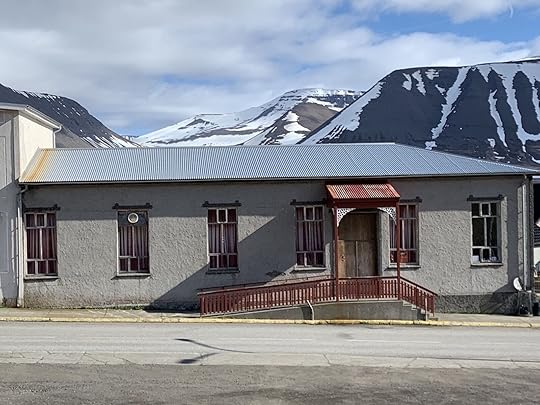
Félagsheimilið, the Thingeyri community center where the disco party was held. Photo: Eben Diskin
I had expected the party’s demographics to match those of the town (i.e. old fishermen), but about half of the 150 or so attendees were under 30 – many from the UK and Europe, and a huge Icelandic contingent from Isafjordur. It was refreshing to see so many Icelanders enjoying the event they so graciously hosted.
Though the start time was clearly advertised, the closing time was the ever-encouraging and dangerous “?” Midnight passed, then 1:00 AM, then 2:00 AM. I tapped out around 2:30 AM, impressed by how many people were still dancing. As I left with a journalist and the influencer, we looked behind us to see our pregnant colleague, admirably and soberly dancing into the morning hours.
Spending the day in ThingeyriMy press group was scheduled to spend the next day outside of Thingeyri, visiting a museum and brewery in Isafjordur. I decided to hang back.
“What’s there to do in Thingeyri?” another journalist asked me. “You can see the whole town in 10 minutes.”
He didn’t quite understand the nature of my FOMO (fear of missing out). Usually, FOMO manifests as a fear of missing something – a party, a night out, a viral moment. For me, it was a fear of missing nothing. In places like Thingeyri, the nothing is often more revealing than the something.
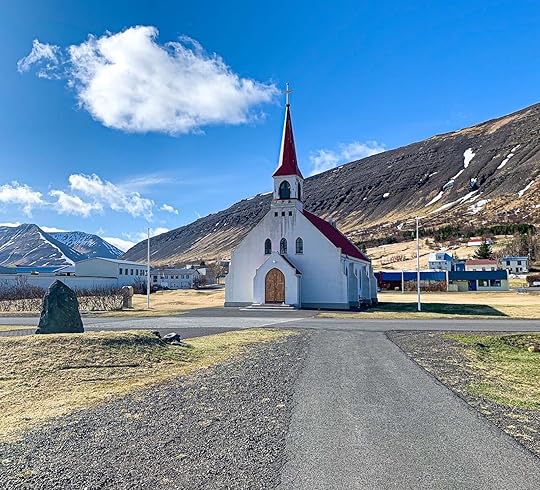
Photo: Eben Diskin
To me, the most intriguing part of this “party at the edge of the world” wasn’t necessarily the party itself, but Thingeyri, a village that daringly opened its arms to the madness of Detour Discotheque. Geographically, the village might be explorable in under 10 minutes, but truly understanding the place would take a bit longer.
I spent the morning in the Blue Bank (Blábankinn) co-working space. A striking blue building, the bank hosts workshops and facilitates startup ventures (I live in a town of 18,000 people, and we don’t have a place like this). It’s all run by a woman named Birta, who graciously unlocked the building for me and let me leech off the free WiFi.
That weekend, the bank also served as a makeshift base of operations for party organizers. I met people from Germany, Italy, California, and of course, Thingeyri. From discotheque organizers to DJs to visiting remote workers, all seemed mildly hungover from the night before.
“Have you tried the waffles?” a local photographer asked me. He was working on the couch across from me.
“Where?”
It was a stupid question. The Simbahöllin cafe was the only place in town that served food.
“They do the best waffles you’ve ever had. Trust me.”
A 12-second walk later I found myself at Simbahöllin, indulging in sweet potato soup, brown freshly-baked bread, and, of course, waffles. Located in an old Norwegian timber house, the cafe looks like an early 20th-century cabin converted into a three-room coffee shop, and smelled like a mix of waffles and cinnamon.
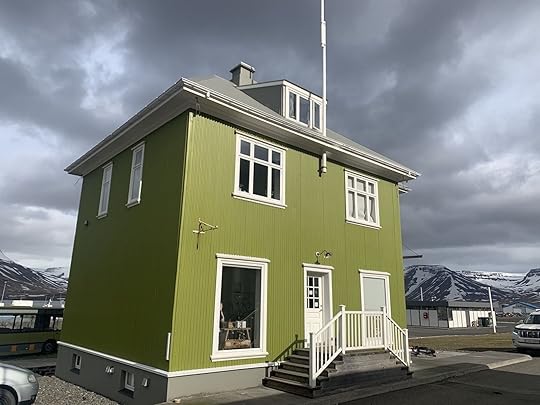
The Simbahöllin cafe. Photo: Eben Diskin
The lone “restaurant” in Thingeyri, it also seemed to be a crossroads for community socialization, like an office water cooler where people gathered to eat, chat, read, work, and linger. The owner sat at a table by the window, reading a book. A man I had seen that morning selling furs out of his house was trying to decide between a cinnamon bun or a waffle. On an old couch in the corner, a DJ from London perused a coffee table cookbook. Two women in swimsuits strolled past the window, in 36 degree weather, en route to the community pool.
In the Simbahöllin I was no longer a tourist in Thingeyri who was disrupting the peace of this minding-its-own-business village for vodka-fueled thrills. I realized, for the first time, that Thingeyri wasn’t merely the backdrop for a quirky disco event – it was the event, with colorful characters and a rhythmic beat that matched, or even drowned out, the disco music. Without Thingeyri, there could be no wormhole.
“Didn’t I tell you?” said the photographer, diving into his waffles a few seats away from me. “They taste like clouds.”
A second night of discoView this post on InstagramA post shared by Detour Discotheque (@detourdisco)
The first night of the disco party, I had walked into the venue not knowing anyone except the journalists. Night two felt more like walking into my local bar on a typical Saturday night.
The photographer from the Blue Bank milled around the community hall taking pictures; the owner of Simbahöllin, pensively immersed in his book that afternoon in the cafe, danced like a wild man by the stage; Birta, who ran the Blue Bank, waved hello with vodka in hand; the women in swimsuits, earlier defying the Iceland chill, stood by the bar in gold, glittering 70s dresses – all while the DJ from the Simbahöllin couch spun disco remixes.
This was what Detour Discotheque was all about. Not recreating a glamorous ‘70s nightclub, or even throwing a debaucherous banger to rival the best of London or New York. It was about holding your breath with complete strangers while your propeller plane landed in a snowy fjord. It was about bringing people from all over the world together in an old community hall. It was about a guy from Boston sharing waffles with people from Iceland and London. The wormhole didn’t open when I entered the makeshift nightclub – it had opened when I set foot on the plane to the Westfjords.
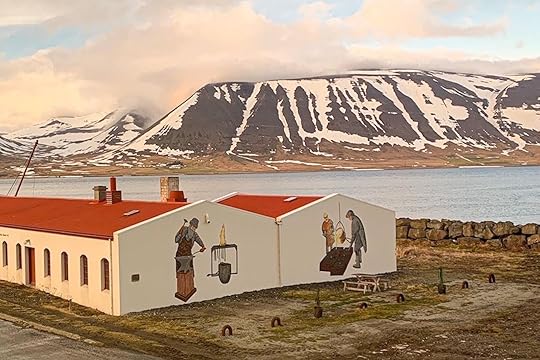
Photo: Eben Diskin
After three days in Thingeyri that felt like three surreal months, my press group left for Reykjavik bleary-eyed and hungover. I looked out the window as we glided too-close-for-comfort over snow-capped peaks. The journalist beside me bopped away to Hermigervill, an Icelandic DJ who had played the night before. The influencer was immersed in her phone, filtering her memories for public consumption.
“Next year, everyone?” we asked each other before parting ways at the airport, a vague promise to reconvene for the next Detour Discotheque – wherever in the world it might be.
“Sure,” I said. “Sounds cool.”
This New Cabo Resort Is The Perfect Spot To Reinvigorate Your Love For Travel

Three words rang in my head as I landed at Los Cabos International Airport on Mexico’s Baja Peninsula in the spring of 2022: I’m back, baby. Only a year ago I’d jumped on the digital nomad trend to live and work from anywhere in the world. Cabo had been the first destination on my nomadic journey.
We hope you love the Corazón Cabo Resort & Spa! Just so you know, Matador may collect a small commission from the links on this page if you decide to book a stay. Listed prices are accurate as of the time of publication.
I remember days filled with sun and sand, Thursday night art walks in San Jose del Cabo, which, along with Cabo San Lucas, makes up the area known as Los Cobos. I’d spent mornings taking meetings in trendy cafes and spent the weekends hanging on the beach with new friends. I indulged in all the many farm-to-table restaurants (my absolute favorite was Flora Farms).
As I landed, my mind flooded with these memories of how I’d first got my feet wet as a traveling remote worker. From practicing broken Spanish in the grocery store, to searching for the best places to buy natural hair products, to thinking about all the ways I’d pushed myself out of my comfort zone as I adjusted to this new location-independent lifestyle.
However, I was here on a different mission. Graduating from the shoddy co-living spaces I’d experienced before, I was fortunate to be able to spend the week celebrating my 10-month nomad journey, all while simultaneously celebrating the remodel and grand opening of the Corazón Cabo Resort & Spa (formerly Cabo Villas). Though I wouldn’t be establishing the tentacles of nomad roots this time around, the hotel captured what I loved so much about Cabo and had me ecstatic to be back.
Corazón Cabo Resort provides a new level of luxury and convenience
Photo: Corazón Cabo Resort
“This is Noble House’s first property in Mexico, and we felt it important to set a precedent within the region regarding the level of luxury and service that’s synonymous with our brand,” says Sean Mullen, president of acquisition, sales, and revenue for Noble House Hotels & Resorts. “The result is an impressive and exceptional experience from rooms to rooftops. Noble House properties are also known to cater to adventurers at heart, and the prime location of Corazón answers that call to a tee.”
Corazón Cabo resort is a 30-minute scenic drive from the Los Cabos International Airport. Its lobby, light and airy, greeted me with historic Mexican artwork ranging from sculptures produced by local craftsmen to paintings depicting the area’s diverse wildlife. The space perfectly reflects its prime location, being situated where the Sea of Cortez and the Pacific Ocean collide. I admired the artwork as I waited for my room, a warm compliment to the work of Mexican architect Arnoldo Rábago of RACO, who designed the resort. I could see the inspiration he drew from Mexico’s rich history.
Corazón Cabo has 187 hotel rooms and 17 luxury suites, ranging from 358 to 945 square feet. One thing I’ve learned from my travels is to always ask for an upgrade. It paid off this time, as I enjoyed a panoramic view of the Land’s End landmark, with a hot tub on the balcony. I enjoyed the rustic yet elegant aesthetic of the room, set in plush and pastel colors. In addition, the floor-to-ceiling glass sliding doors welcomed the outdoors inside and connected the room to the surrounding natural elements.
An ideal basecamp for exploring Cabo’s iconic outdoor adventures
Photo: Corazón Cabo Resort
I had never heard of flyboarding prior to coming here, but the name alone piqued my interest enough to make me sign up for the water experience without hesitation through a local outfitter called Cabolectric. Like my nomad journey itself, the flyboarding adventure was full of surprises. Once you put on the hydro-like sneakers, a boat floats you out to the middle of the ocean and the force from the water that shoots out of the boots puts you high into the air. After repeated tries to stand up underwater, I found success and the pressure was on. Up, up, and away I went, wanting to scream but too enamored by the experience to do so.
During the trip, I also experienced a catered boat ride with Animalón by the Sea, which is a floating restaurant run by chef Javier Placencia that applies the farm to table mantra to seafood. This experience was the perfect way to do sightseeing and water activities such as snorkeling and swimming by Cabo’s iconic arch.
A comfortable stay enhanced by a resort that perfectly captures the spirit of Cabo Book Corazón Cabo Now
Book Corazón Cabo Now
The 8 Best Nude Beaches in the Caribbean

Few travel experiences are as adventurous as nude sunbathing. It’s not exactly something most people choose to regularly do at home. And while it doesn’t have the adrenaline jolt of downhill skiing or whitewater rafting, it’ll get you out of your comfort zone faster than any extreme sport. You also don’t need to travel far to find beautiful places to sunbathe in the buff, as some Caribbean nude beaches are just a short flight away.
These eight nude beaches in the Caribbean may pique your curiosity on your next trip over.
1. Gouverneur Beach, St. Barts
Photo: Sandra FoytShutterstock
This secluded cove on the southern shore of St. Barts is one of the odd beaches on the island with no development nearby. That makes the white sand an ideal place for nude sunbathing, with nobody gawking from their hotel balconies. Reaching the turquoise water is an adventure in itself, as you’ll need to traverse a steep, narrow road to reach a viewpoint above the beach. Take in the scenery, then head down to the parking lot, through some trees, and on to the family section of the beach.
While this first section of Gouverneur Beach is great for kids and has world-class snorkeling, if you’re looking to disrobe you’ll need to turn right and keep going to the other end. Make sure you pack your sunscreen, as this beach has no amenities and the sun is strong — especially on parts where it doesn’t usually shine.

Photo: Christy70Shutterstock
This beach, named after a beak-shaped rock, is actually a collection of four beaches set alongside the Hawksbill resort. While the beach is technically part of resort property, it is open to the public for sunbathing, clothed or otherwise. Other than the resort’s cottages dotting the shoreline, the beach feels completely secluded, tucked at the foot of deep green mountains with calm, powder blue waters. If you’re planning on tanning au naturel, make sure you do it at Eden Beach, the only one of the four that’s clothing optional. Most days it’ll be obvious, but if you show up on a slow day, definitely double check.
3. Pointe Tarare, Guadeloupe
Photo: photobeginnerShutterstock
Guadeloupe’s lone clothing optional beach is as far flung as it gets on the tip of Pointe de Chateaux on the southeastern shore of Grand Terre. It’s about a ten-minute drive from the marina at St. Francois, but feels a world away. Epic limestone cliffs sit just around a small point from this crescent-shaped beach, where thick tropical foliage and a couple of palm trees make the landscape seem completely deserted. Fortunately, you’re not as removed from civilization as you’d like to imagine, so if you’re hankering for a soda or a snack you need only go to the stands in Point Tarare’s parking lot to find them.
4. Seven Mile Beach, Jamaica
Photo: VIG-VamShutterstock
Obviously, not all of Seven Mile Beach is clothing optional, as much of it fronts family friendly resorts in tourist-filled Negril. The part we’re talking about, however, fronts the notorious Hedonism II, the world’s premiere “lifestyle” resort where guests openly stroll the sand, sans clothes.
Since the beach is open to the public, aspiring nude sunbathers can absolutely join in the tanline avoidance. Just try not to peek your head too far over the foliage to see what’s going on inside; Hedo guests value their privacy so lookieloos will be shooed away quickly. Still, it’s a chance to experience one of the most beautiful Caribbean nude beaches (and, frankly, one of the most beautiful beaches in the Caribbean overall) in a totally new way, and is worth the walk if you’re staying at another property nearby.
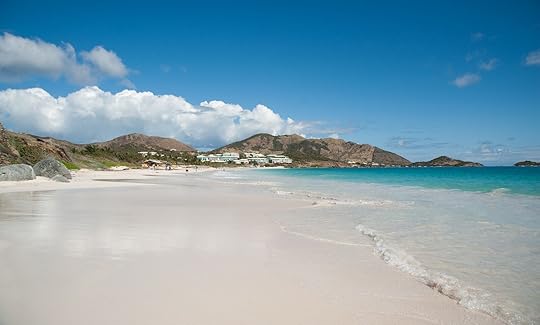
Photo: Zina SeletskayaShutterstock
Orient Beach is among the most popular on the French side of Saint Martin, as the northern section is home to the funky Perch Bar and the remains of the Club Orient Resort. But venture a little farther south and you’ll find the clothing optional section, where chair and umbrella rentals are readily available so you can nude sunbathe in the shade. The beach itself is a stunner, with classic Caribbean aquamarine waters and gentle surf, perfect for a little sunny skinny dipping — though you’ll need to watch out for kitesurfers who frequent the area.
Once you put your clothes on, you’re also a short walk to Orient Village, which offers a handful of newer beach bars as well as full-service restaurants. As Caribbean nude beaches go, few offer more than Orient, and it’s easily the best to plan a full day around.

Photo: jlazouphotoShutterstock
The important thing to remember if you’re planning to visit this undeveloped beach in the southeast of Martinique is that most of the beach isn’t nude. The main beach, Anse de Salines, is a wide stretch of white sand with a thick forest and shady picnic tables near Big Salt Bay. While it’s never crowded, per se, it will be filled with more-clothed visitors (topless sunbathing is pretty common throughout the French Caribbean) so you’ll need to find one of the more remote stretches to bare all. Once you’ve found your spot, you’ll be practically alone with clear, turquoise waters and palm trees jutting out from the wilderness at peculiar angles. It’s a natural paradise in every sense, and so long as you don’t wander too far nobody will bother you.
7. Playa Suecas, Panama
Photo: Olena BolotovaShutterstock
The only nude beach in Panama is set far from the mainland, on the southeast corner of Contadora Island. “Swedish Beach” is bordered by rocks on both sides, part of the reason taking it all off feels less risky. You won’t find much other than some shady trees and dense foliage on Playa Suecas, but if deep-tan sand and bright blue waters are your beach ideals, then Playa Suecas is a dream. It’s not easy to find, though. You’ll have to head to the eastern end of nearby Playa Larga, wander through the breaks in the rocks, and set up shop a hundred or so yards away.
8. Anse de Grand Saline, St. Barts
Photo: NaeblysShutterstock
If you’re hiking to the natural pools at Grand Fond on the southern shore of St. Barth’s, meander a little farther down the coast and you’ll find this unexpected, uncrowded beach. It’s about as remote a spot as you can get on this luxe island, where if you’re there during the rainy season it appears as a sandy oasis at the end of a jungle. The green hills seem to drop straight down into the sea at Anse de Grand Saline, offering one of St. Bart’s most dramatic beachscapes. The area itself is pretty secluded, so pack lunch, water, or whatever else you might need. That said, if you’re willing to drop a car payment on lunch, L’Esprit is a short walk away. 
The 7 Best Old-School Italian Restaurants in Atlantic City

Like every American tourist destination, Atlantic City, New Jersey was hit hard by COVID-19. While the nine major casinos are mostly the reason that people flock to AC, the chorus lyrics from the Bruce Springsteen acoustic song of 40 years past still ring true today: People from nearby Philly, North Jersey, and even NYC are still putting on their makeup, fixing their hair, and meeting in Atlantic City (sometimes lovingly referred to as the Vegas of the Northeast). And they are eating at some of the best traditional Italian restaurants in the country.
The boardwalk, beaches, and casinos remain AC’s main attractions, but even vacationers busy at the slot machines need to eat. Since it’s New Jersey, Italian food is the go-to, and there are several traditional Italian restaurants in Atlantic City worth trying. They range from intimate hole-in-the-wall spots where the walls are lined with pictures of every celebrity who dined there since pre-casino days to fancy white tablecloth establishments straight out of a 1990s Scorsese film.
Here’s what you need to know before stopping into any of these restaurants for dinner: All of the traditional Italian restaurants on this list are closed Monday, with the exception of Girasole. And none serve lunch. Interested parties should plan to make a reservation, especially on weekends. For Chef Vola’s, you’ll likely need reservations weeks in advance. Otherwise, the restaurant will put you on a waiting list.
The farther you get from the boardwalk, the more likely these traditional Italian restaurant is to have a private parking lot. This is the case with Angelo’s, Angeloni’s, and Cafe 2825. For the rest, you’ll have to use a paid lot or metered street parking. All are within a 10-minute drive from the boardwalk.
So for your next trip to Atlantic City, we recommend skipping the casino buffets, foregoing the boardwalk food, and instead trying one of these traditional Italian restaurants.
Angelo’s Fairmount Tavern
Photo: Brian Cicioni
If you’re driving into town via the Atlantic City Expressway, the giant red Angelo’s sign will be one of the first things you’ll see. Located on the edge of the former Italian-American enclave of Ducktown, Angelo’s Fairmount Tavern (named after the address at the intersection of Fairmount and Mississippi) has been serving Mancuso family recipes since 1935.
You’ll see a lot of baseball-sized meatballs served here, to patrons who are more than used to watching first-timers gawk at the sports memorabilia that adorns every wall. In fact, Angelo’s can easily double as a sports museum. The restaurant’s decadent lobster ravioli served in a blush sauce, topped with jumbo lump crab meat and a six-ounce lobster tail, is a popular special.
Angeloni’s II
Photo: Brian Cicioni
Located in the heart of Ducktown, Angeloni’s II started in Trenton and is also one of the most beloved red sauce joints in Atlantic City. If you use the Arctic Avenue entrance, you’ll likely feel like you’ve entered a neighborhood sports bar rather than an old-school Italian restaurant. While the bar is probably the most fun spot (especially if you’re a Yankees fan), there are also two white tablecloth dining rooms with some of the more than 350 wine bottles on offer nestled into the walls.
The veal dishes are the most popular, especially the brasciole. Ask the staff why people come to Angeloni’s, and they’ll be quick to tell you that it’s the red sauce and wine selection that keeps patrons coming back. The meatballs are also a mainstay. Stop by on a Thursday night, and you can have two free meatballs with each martini.
Cafe 2825
Photo: Brian Cicioni
At Cafe 2825, even the menu has an “old school” section of Neapolitan and Sicilian appetizers. While it’s known for their Southern Italian and Sicilian small plates, first-timers should try one of the restaurant’s four tableside experiences. While you can’t go wrong with the handmade warm burrata (which they prepare straight from the curd) or old-world caesar salad, it’s the cacio e pepe that you’re likely to see at every other table.
And first-time patrons may think they found that one New Jersey Italian restaurant without a picture of the Sopranos hanging on the wall, but there is one in the men’s bathroom, and it’s more than double the size of the nearby black and white vintage shots of old Yankee Stadium.
Capriccio
Photo: Brian Cicioni
The only casino restaurant on this list dates back to 1979. Capriccio serves high-end Italian fare in an elegant setting with white tablecloth, high ceilings as well as ten incredibly detailed murals of the Carnevale di Venezia, or Carnival of Venice. You might expect a place like this to serve small portions, but it’s the complete opposite, as the portions border on family-style. Many come here for the veal, which will be a tenderloin cut, regardless of which preparation you order.
During the warmer months, you’ll have the option to forego the main dining area for veranda seating, just one floor above the famous Atlantic City boardwalk. Thanks to the smell of saltwater along with views of The Wheel and the possibility of random nightly boardwalk entertainment, this seating arrangement can be just as enjoyable as sitting under an ornate chandelier in the main dining room.
Chef Vola’s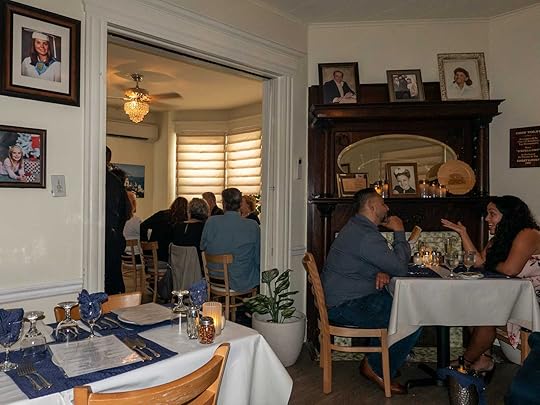
Photo: Brian Cicioni
Chef Vola’s is exclusive without being pretentious. The restaurant has no working website, nor do they use social media. And it just started accepting credit cards in 2020.
The fact that the restaurant is located at the end of a one-way street, where half of the buildings are boarded up, does not deter patrons from Beyonce and Jay-Z to Chris Christie and a who’s who of former Sopranos cast members from trying to score a coveted table. But you need to call weeks in advance to get one of those.
Once you’re seated, your server will go over the menu with a confidence comparable to that of a car salesman, but without the pressure. The signature pounded rib veal chop is their most popular dish. While not a traditional Italian dish, the crab cakes are worth a try, especially if you’re tired of overpaying for hockey puck-sized imposters where you can’t find actual crab meat.
Girasole
Photo: Brian Cicioni
Girasole is the most romantic Italian restaurant in Atlantic City. It’s also the only place on this list that serves pizza. The restaurant uses wheat flour imported from Naples, which is where the Iovino family emigrated from in the late 1980s. 17 family members currently work at this dimly lit lounge-esque Southern Italian Restaurant.
While you can’t go wrong with any of the pies, you should also try the whole branzino baked in sea salt. The team will filet the fish at your table and serve it with a side of greens. There are also eight different carpaccio options, with the namesake girasole being the most popular. The funghi is topped with shiitake and porcini mushrooms which are served hot enough to cook the ultra-thin slices of filet mignon. For dessert, try the croccantino, which you will not find at any of the other old-school Italian restaurants on this list.
Scannicchio’s
Photo: Brian Cicioni
The original location was destroyed by Hurricane Sandy, but Sacchianno’s is now operating in a shared space with Lefty’s Pub & Grub, just outside Ducktown. Inside, the place is nothing fancy, but the food is as good as any you’ll get in a white tablecloth restaurant.
Try one of their namesake dishes: The Seafood Scannicchio is a condensed version of The Feast of the Seven Fishes, but with all shellfish, including lobster, over a bowl of pasta. You’ll have the option of red sauce, white, or fra diavolo.
If you’re more of a meat lover, try the Steak Big John, which is named after 84-year-old owner John Varalli. The 12-ounce strip is topped with breaded shrimp and scallops and then finished off with a thin layer of mozzarella cheese. If you can’t make it to Atlantic City, you can also check out the other Scannicchio’s, which is located off the Broad Street Line in South Philly. 
Matador Network's Blog
- Matador Network's profile
- 6 followers



